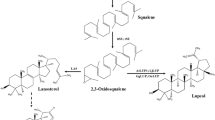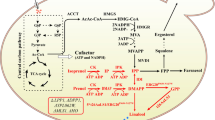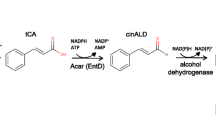Abstract
Lupulones, naturally produced by glandular trichomes of hop (Humulus lupulus), are prenylated phloroglucinol derivatives that contribute the bitter flavor of beer and demonstrate antimicrobial and anticancer activities. It is appealing to develop microbial cell factories such that lupulones may be produced via fermentation technology in lieu of extraction from limited plant resources. In this study, the yeast Saccharomyces cerevisiae transformants harboring a synthetic lupulone pathway that consisted of five genes from hop were constructed. The transformants accumulated several precursors but failed to accumulate lupulones. Overexpression of 3-hydroxy-3-methyl glutaryl co-enzyme A reductase, the key enzyme in precursor formation in the mevalonate pathway, also failed to achieve a detectable level of lupulones. To decrease the consumption of the precursors, the ergosterol biosynthesis pathway was chemically downregulated by a small molecule ketoconazole, leading to successful production of lupulones. Our study demonstrated a combination of molecular biology and chemical biology to regulate the metabolism for heterologous production of lupulones. The strategy may be valuable for future engineering microbial process for other prenylated natural products.




Similar content being viewed by others
References
Almaguer, C., Schönberger, C., Gastl, M., Arendt, E. K., & Becker, T. (2014). Humulus lupulus—a story that begs to be told. A review. Journal of the Institute of Brewing, 120, 289–314.
Steenackers, B., De Cooman, L., & De Vos, D. (2015). Chemical transformations of characteristic hop secondary metabolites in relation to beer properties and the brewing process: a review. Food Chemistry, 172, 742–756.
Cleemput, M. V., Cattoor, K., Bosscher, K. D., Haegeman, G., Keukeleire, D. D., & Heyerick, A. (2009). Hop (Humulus lupulus)-derived bitter acids as multipotent bioactive compounds. Journal of Natural Products, 72(6), 1220–1230.
Lamy, V., Roussi, S., Chaabi, M., Gosse, F., Schall, N., Lobstein, A., & Raul, F. (2007). Chemopreventive effects of lupulone, a hop β-acid, on human colon cancer-derived metastatic sw620 cells and in a rat model of colon carcinogenesis. Carcinogenesis, 28(7), 1575–1581.
Justé, A., Krause, M. S., Lievens, B., Klingeberg, M., Michiels, C. W., & Willems, K. A. (2007). Protective effect of hop β-acids on microbial degradation of thick juice during storage. Journal of Applied Microbiology, 104, 51–59.
Pollach, G., Hein, W., & Beddie, D. (2002). Application of hop β-acids and rosin acids in the sugar industry. Zuckerindustrie, 127, 921–930.
Nagel, J., Culley, L. K., Lu, Y., Liu, E., Matthews, P. D., Stevens, J. F., & Page, J. E. (2008). EST analysis of hop glandular trichomes identifies an O-methyltransferase that catalyzes the biosynthesis of xanthohumol. Plant Cell, 20(1), 186–200.
Xu, H., Zhang, F., Liu, B., Huhman, D. V., Sumner, L. W., Dixon, R. A., & Wang, G. (2013). Characterization of the formation of branched short-chain fatty acid: CoAs for bitter acid biosynthesis in hop glandular trichomes. Molecular Plant, 6(4), 1301–1317.
Okada, Y., Sano, Y., Kaneko, T., Abe, I., Noguchi, H., & Ito, K. (2004). Enzymatic reactions by five chalcone synthase homologs from hop (Humulus lupulus L.). Bioscience Biotechnology and Biochemistry, 68(5), 1142–1145.
Li, H., Ban, Z., Qin, H., Ma, L., King, A. J., & Wang, G. (2015). A heteromeric membrane-bound prenyltransferase complex from hop catalyzes three sequential aromatic prenylations in the bitter acid pathway. Plant Physiology, 167(3), 650–659.
Zhou, Y. J., Gao, W., Rong, Q., Jin, G., Chu, H., Liu, W., Yang, W., Zhu, Z., Li, G., Zhu, G., Huang, L., & Zhao, Z. K. (2012). Modular pathway engineering of diterpenoid synthases and the mevalonic acid pathway for miltiradiene production. Journal of the American Chemical Society, 134(6), 3234–3241.
Horton, R. M., Hunt, H. D., Ho, S. N., Pullen, J. K., & Pease, L. R. (1989). Engineering hybrid genes without the use of restriction enzymes: gene splicing by overlap extension. Gene, 77(1), 61–68.
Gietz, R. D., & Schiestl, R. H. (2007). Frozen competent yeast cells that can be transformed with high efficiency using the LiAc/SS carrier DNA/PEG method. Nature Protocols, 2(1), 1–4.
Szkopihska, A., Grabihska, K., Delourme, D., Karst, F., Rytka, J., & Palamarczyk, G. (1997). Polyprenol formation in the yeast Saccharomyces cerevisiae: effect of farnesyl diphosphate synthase overexpression. Journal of Lipid Research, 38, 962–968.
de Macedo-Silva, S. T., Visbal, G., Urbina, J. A., de Souza, W., & Rodrigues, J. C. (2015). Potent in vitro antiproliferative synergism of combinations of ergosterol biosynthesis inhibitors against Leishmania amazonensis. Antimicrobial Agents and Chemotherapy, 59(10), 6402–6418.
Jachak, G. R., Ramesh, R., Sant, D. G., Jorwekar, S. U., Jadhav, M. R., Tupe, S. G., Deshpande, M. V., & Reddy, D. S. (2015). Silicon incorporated morpholine antifungals: design, synthesis, and biological evaluation. ACS Medicinal Chemistry Letters, 6(11), 1111–1116.
Rodrigues, J. C. F., Concepcion, J. L., Rodrigues, C., Caldera, A., Urbina, J. A., & de Souza, W. (2008). In vitro activities of er-119884 and e5700, two potent squalene synthase inhibitors, against Leishmania amazonensis: antiproliferative, biochemical, and ultrastructural effects. Antimicrobial Agents and Chemotherapy, 52(11), 4098–4114.
Tang, F., Zhou, X., Yang, J., Xu, J., & Li, R. (2009). Study on accumulating lycopene by ergosterol synthesis inhibitor in Rhodothece RY-17. Pharmaceutical Biotechnology, 16, 64–67.
Urbina, J. A., Concepcion, J. L., Caldera, A., Payares, G., Sanoja, C., Otomo, T., & Hiyoshi, H. (2004). In vitro and in vivo activities of e5700 and er-119884, two novel orally active squalene synthase inhibitors, against Trypanosoma cruzi. Antimicrobial Agents and Chemotherapy, 48(7), 2379–2387.
Peng, B., Plan, M. R., Chrysanthopoulos, P., Hodson, M. P., Nielsen, L. K., & Vickers, C. E. (2017). A squalene synthase protein degradation method for improved sesquiterpene production in Saccharomyces cerevisiae. Metabolic Engineering, 39, 209–219.
Donald, K., Hampton, R., & Fritz, I. (1997). Effects of overproduction of the catalytic domain of 3-hydroxy-3-methylglutaryl coenzyme a reductase on squalene synthesis in Saccharomyces cerevisiae. Applied and Environmental Microbiology, 63, 3341–3344.
Engels, B., Dahm, P., & Jennewein, S. (2008). Metabolic engineering of taxadiene biosynthesis in yeast as a first step towards taxol (paclitaxel) production. Metabolic Engineering, 10(3-4), 201–206.
Grabowska, D., Karst, F., & Szkopinèska, A. (1998). Effect of squalene synthase gene disruption on synthesis of polyprenols in Saccharomyces cerevisiae. FEBS Letters, 434(3), 406–408.
Clark, S. M., Vaitheeswaran, V., Ambrose, S. J., Purves, R. W., & Page, J. E. (2013). Transcriptome analysis of bitter acid biosynthesis and precursor pathways in hop (humulus lupulus). BMC Plant Biology, 13(1), 12.
Ignea, C., Pontini, M., Maffei, M. E., Makris, A. M., & Kampranis, S. C. (2014). Engineering monoterpene production in yeast using a synthetic dominant negative geranyl diphosphate synthase. ACS Synthetic Biology, 3(5), 298–306.
Bi, H., Bai, Y., Cai, T., Zhuang, Y., Liang, X., Zhang, X., Liu, T., & Ma, Y. (2013). Engineered short branched-chain acyl-CoA synthesis in E. coli and acylation of chloramphenicol to branched-chain derivatives. Applied Microbiology and Biotechnology, 97(24), 10339–10348.
Karkashon, S., Raghupathy, R., Bhatia, H., Dutta, A., Hess, S., Higgs, J., Tifft, C. J., & Little, J. A. (2015). Intermediaries of branched chain amino acid metabolism induce fetal hemoglobin, and repress sox6 and bcl11a, in definitive erythroid cells. Blood Cells, Molecules, and Diseases, 55(2), 161–167.
Dickinson, J. R., Harrison, S. J., & Hewlins, M. J. E. (1998). An investigation of the metabolism of valine to isobutyl alcohol in Saccharomyces cerevisiae. The Journal of Biological Chemistry, 273(40), 25751–25756.
Dickinson, J. R., Salgado, L. E., & Hewlins, M. J. (2003). The catabolism of amino acids to long chain and complex alcohols in Saccharomyces cerevisiae. The Journal of Biological Chemistry, 278(10), 8028–8034.
Lian, J., Jin, R., & Zhao, H. (2016). Construction of plasmids with tunable copy numbers in Saccharomyces cerevisiae and their applications in pathway optimization and multiplex genome integration. Biotechnology and Bioengineering, 113(11), 2462–2473.
Kim, J. W., Kim, J., Seo, S. O., Kim, K. H., Jin, Y. S., & Seo, J. H. (2016). Enhanced production of 2,3-butanediol by engineered Saccharomyces cerevisiae through fine-tuning of pyruvate decarboxylase and nadh oxidase activities. Biotechnology for Biofuels, 9(1), 265.
Lee, F. W. F., & Silva, D. N. D. (1997). Improved efficiency and stability of multiple cloned gene insertions at the δ sequences of Saccharomyces cerevisiae. Applied Microbiology and Biotechnology, 48(3), 339–345.
Xie, W., Ye, L., Lv, X., Xu, H., & Yu, H. (2015). Sequential control of biosynthetic pathways for balanced utilization of metabolic intermediates in Saccharomyces cerevisiae. Metabolic Engineering, 28, 8–18.
Acknowledgments
The authors thank Prof. Guodong Wang of Institute of Genetics and Developmental Biology, CAS, for provision of strains and plasmids, and Prof. Fan Yang of Dalian Polytechnic University for provision of hop samples.
Funding
This project is supported by National Natural Science Foundation of China (Nos. 21721004; 51561145014) and Dalian Institute of Chemical Physics, CAS (No. DICP ZZBS201605).
Author information
Authors and Affiliations
Corresponding author
Ethics declarations
Conflict of Interest
The authors declare that they have no conflict of interest.
Ethical Approval
This article does not contain any studies with human participants or animals performed by any of the authors.
Additional information
Publisher’s Note
Springer Nature remains neutral with regard to jurisdictional claims in published maps and institutional affiliations.
Rights and permissions
About this article
Cite this article
Guo, X., Shen, H., Liu, Y. et al. Enabling Heterologous Synthesis of Lupulones in the Yeast Saccharomyces cerevisiae. Appl Biochem Biotechnol 188, 787–797 (2019). https://doi.org/10.1007/s12010-019-02957-8
Received:
Accepted:
Published:
Issue Date:
DOI: https://doi.org/10.1007/s12010-019-02957-8




